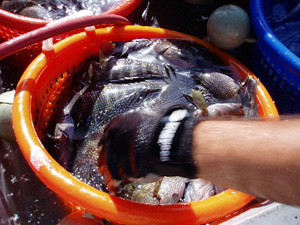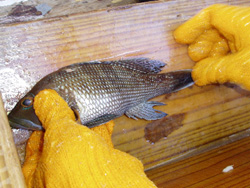|
 |
|
Daily
At-Sea Logs |
| Monday,
May 17, 2004 Today, I think I will do things a bit differently for you folks out there in cyberspace. Since you already know about the kinds of instruments being deployed here, as well as the methods we are using, I thought that it might be neat to explore our catch of the week, the black sea bass.
On
average, black sea bass live to the ripe old age of ten years here
in Gray’s Reef. An adult female will spawn every three to four
days during the spawning season, which lasts for three months each
year for seven years. Although she spawns about ½ million eggs
per year, only 1% will make it to their adult stage. During
the first two weeks their lives, these larval sea bass float in the
open ocean as plankton. They have several features that help them
avoid predation here; they are transparent, as well as have extended
fin rays Young adult sea bass prefer depths of 40 to 60 feet (12 to 18 meters), which makes Gray’s Reef a nearly perfect place for the sea bass to live since depths vary from 50 to 70 feet (15 to 21 meters). The size of the fish varies with depth and, in Gray’s Reef, lengths range from 14 cm to 39 cm (nearly 6 to 16 inches). This variability in size indicates that the sanctuary is home to juveniles, as well as adult black sea bass. The fisheries managers find this great news because it is their job to monitor the stock of black sea bass in the sanctuary, and the size range we have seen this week indicates a healthy population. Unfortunately, humans have impacted the populations of black sea bass here in Gray’s Reef. Beginning in the 1970's, populations of these fish stocks were being nearly-over fished which means that the population of sea bass is approaching the point of being fished where it cannot replenish itself. As a result of overfishing, the average sizes and ages of the sea bass had been declining up through the 1990's. In the past 20 years, scientists have noticed a trend whereas the sea bass are beginning to mature at a younger age because the largest males are removed from the population; and therefore, are not able to reproduce. Recent sampling since 2000, including the samples obtained this week at Gray’s Reef, indicate the black sea bass are increasing in number and size in recent years. The United States government passed a set of laws under the Magnuson - Stevens Act of the 1970's and the Sustainable Fisheries Act in late 1990's that aimed to manage fish populations to a sustainable state. As a result, a limit has been set on the size and number of sea bass that fishermen can catch in the entire southeast region, from North Carolina to Florida. Sea bass must be at least 10 inches long in order for fisherman to keep them, and recreational fisherman cannot take more than 20 a day. Black sea bass are fairly protected here in Gray’s Reef. Fishing techniques, such as long lining and wire trapping are prohibited. Scientists will analyze the data collected on this leg and compare this to historical data to see if this is truly a sanctuary for the black sea bass. In other words, are there more of these fish here than in the rest of the region, as a result of the fishing restrictions? A secondary goal for this project is to compare the various methods of collecting data on the fish in this sanctuary. Managers are interested in comparing the results taken from the trap catches with the ROV footage, dives, video logs, and sonar data to see if these are all reliable ways of monitoring the fish populations here in Gray’s Reef. These data are useful to managers so they can rely more heavily on these less-obtrusive techniques and less on trapping fish. It has been a week since I boarded this ship and it is hard to believe all of the experience and knowledge that I have gained as a result. Prior to joining this crew, my understanding of fisheries was basic, at best. I had no idea the kinds resources, skill, and understanding needed to get a job like this accomplished. Attempting to understand such a dynamic system, such as Gray’s Reef, requires a diverse and interdisciplinary group of resources and I am proud to be a part of this operation. Until
tomorrow,
|
|||||||||


 As
you already know by reading our daily logs, black sea bass (picture
on left) are king of the reef. Black sea bass (also referred
to as Centropristis striata) is found in this area, in part, because
the rocky hardbottom provides a good habitat for the adult black sea
bass, as well as many other fish, such as snapper, grouper, mackerel
and barracuda. This reef is ideal because the sea bass are able to
conceal themselves within it, periodically venturing away from the
reef in search of food such as shrimp, crabs, and small fish.
As
you already know by reading our daily logs, black sea bass (picture
on left) are king of the reef. Black sea bass (also referred
to as Centropristis striata) is found in this area, in part, because
the rocky hardbottom provides a good habitat for the adult black sea
bass, as well as many other fish, such as snapper, grouper, mackerel
and barracuda. This reef is ideal because the sea bass are able to
conceal themselves within it, periodically venturing away from the
reef in search of food such as shrimp, crabs, and small fish. and
spines that help them stay afloat. They receive their nourishment
by feeding on zooplankton in the water column until they mature into
their juvenile stage. As sea bass mature, they develop coloration
similar to the ocean bottom, which allows them to blend in. (picture
on right)This, in turn, enables them to migrate to shallow
oyster reefs and near-shore hard bottom to look for food, where they
remain for a few months, or up to three years.
and
spines that help them stay afloat. They receive their nourishment
by feeding on zooplankton in the water column until they mature into
their juvenile stage. As sea bass mature, they develop coloration
similar to the ocean bottom, which allows them to blend in. (picture
on right)This, in turn, enables them to migrate to shallow
oyster reefs and near-shore hard bottom to look for food, where they
remain for a few months, or up to three years.